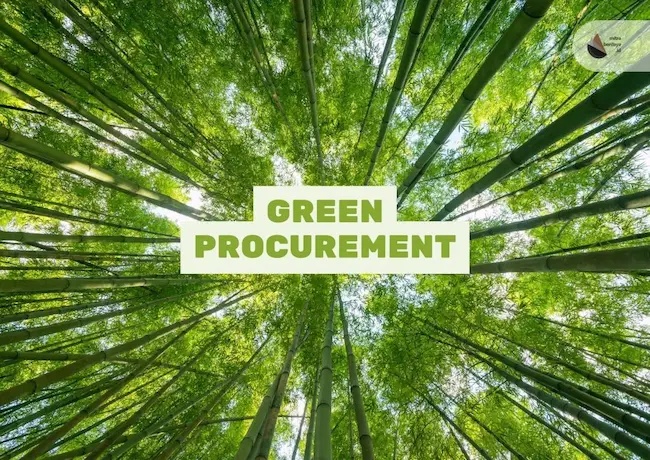Sustainability is no longer an option in modern business; it is now fundamental to responsible, competitive, and effective conduct. The pressure from regulators, consumers and investors is mounting, and businesses need to minimise their environmental impact. Procurement is a key area for effecting change. Green procurement, or sustainable procurement, is the purchase of goods and services with consideration to the environment and social value, rather than purely to cost and quality.
A green procurement policy provides organisations with a structured process to make environmentally responsible purchasing decisions. In this blog, we will investigate the breadth of what a green procurement policy is, the benefits, its application in public and private sector organisations, and how businesses can proceed with developing and implementing one.
Green Procurement Policy
A green procurement policy is a formal set of guidelines that a firm will use to shape its purchasing practices in the direction of buying environmentally sustainable products and services. This policy will help your firm identify, select and procure suppliers that utilize sustainable, recycled or renewably sourced materials, limit energy consumption and emissions, and minimize waste.
Green procurement will push firms to address a critical additional dimension of purchasing beyond price and quality, which is long-term sustainability. Green procurement compels firms to ask not only the question “What does this product cost?” but also “What will be the environmental impact of this decision on the environment for its life cycle?”
The policy will deal with considerations such as:
Having a preference for products that have recyclable or biodegradable packaging.
Selecting suppliers that are environmentally compliant.
Avoid suppliers with known unethical practices in the supply chain.
Selecting energy-efficient products and responsibly-sourced products.
By building a formal policy that sets out the criteria for decision-making, firms will be able to ensure that sustainability considerations are front and centre in their purchasing decisions, rather than being an afterthought.

Why would businesses want to adopt a green procurement policy?
The rationale for businesses adopting a green procurement policy is very compelling for numerous reasons.
The first is environmental impact: green procurement policies utilise purchasing to focus on reducing greenhouse gas emissions, conserving raw materials, and minimising waste. Businesses that use green procurement are helping, in some small way, to do their part in creating a new economy that promotes sustainability. Actions by businesses, however small, prompt active engagement with local, national, and global sustainability goals, which include alignment with goals such as the UN Sustainable Development Goals (SDG).
The second rationale is economics: green products sometimes cost more at the time of purchase but typically can be more economical in the long run because they save energy, last longer, and decrease disposal costs. An example would be energy-efficient equipment that costs more to purchase but reduces energy bills significantly over its lifetime.
Thirdly, sustainability enhances brand reputation. Consumers and clients today are more likely to support businesses that show evidence of caring for sustainability in procurement than those that do not. A plan to pursue responsible procurement is a plan to demonstrate corporate responsibility, which builds customer loyalty and trust.
Moreover, with the increasing focus on compliance requiring some environmentally sustainable model, businesses with a plan for green procurement can stay ahead of regulations with less risk of penalties and downtimes. Internally, businesses with sustainable plans can increase employee morale, as it is a preference of many employees to work in organisations that care about their stewardship of the planet.
Green Procurement in the Public Sector
Public sector organisations are often the most comprehensive users of the green procurement model of procurement. Governments know of their ability to influence markets and direct change, given their large purchasing capacity.
For example, common practice for municipalities is to require contractors in construction to use sustainable products, such as making energy-efficient lighting mandatory in public buildings or allowing only energy-efficient appliances in public buildings from suppliers. Other governments mandate that suppliers have environmental certifications or operate on a low-carbon basis. In the case of government green criteria, products must not meaningful contribute to carbon emissions or contribute to a wider net benefit.
The practice of acquiring green goods through green procurement in the public sector helps not only to whittle away at the government’s carbon footprint, but also provides a rationale for private businesses. By purchasing from environmentally responsible suppliers, government green procurement generates demand for sustainable supply chains, making green goods available to society and less expensive for private enterprise use.

Green Procurement in the Private Sector
Increasingly, the concept of green procurement has become a competitive differentiator for many firms in the private sector. Firms, ranging from retailers to manufacturers to technology firms to hospitality, now include sustainability in their procurement activities.
Firms in the private sector adopt these policies on a voluntary basis due to customer need, investor interest, or commitments made through corporate social responsibility. For example, a large global retail chain would require suppliers to have some regard for packaging waste and practices that are more energy efficient than in the past, while a technology firm may enlist only those firms that would responsibly recycle electronic components.
Unlike the public sector, where some sustainability practices are regulated and enforced, firms in the private sector generally implement green procurement practices to differentiate themselves from businesses that do not. Firms that would like to adopt green procurement practices will likely discover that the creation of partnerships is easier to develop, they will maintain environmentally conscious customers, and they will sustain resilient operations.
What Should a Green Procurement Policy Include
A competent green procurement policy must be actionable and complete. The specifics of the policy will depend on the organisation and industry, but an effective green procurement policy will be one that includes at a minimum:
Explicit Goals – For example, the organization might aim to reduce CO2 emissions by a certain percentage, limit waste by a certain amount, or procure from fair-trade suppliers.
Environmental Criteria for Suppliers – For example, suppliers may be required to comply with environmental legislation, provide proof that their packaging is recyclable, or have a certified eco-label.
Product Specifications – Specify requirements for products, including recyclability or reused products, terms of original packaging, minimal lifetime impact or durability.
Monitoring & Review – What systems do you have in place to evaluate supplier performance and to regularly review procurement decisions?
Improvement Process – Sustainability is not static, so there is a need to acknowledge that goals will change and be prepared to make changes to the policy.
Training & Messaging – How will staff ensure they understand how to action the policy, as well as take responsible purchasing decisions?
When businesses include these aspects in their Green Procurement Policies, they can create not only guidelines for sustainability, but also accountability for sustainability throughout the supply chain.
Company examples of companies that succeed in green procurement
Many of the leading companies in green procurement have set powerful examples of how companies can transform their business processes.
IKEA – IKEA is well-known for its sustainability goals, and has embedded purchasing decisions into its core strategy as opposed to treating it as an isolated activity. IKEA even sources wood from responsibly managed forests and has committed to using only recycled and renewable materials.
Unilever – Unilever establishes sustainability targets with its suppliers based on its “Sustainable Living Plan.” Unilever has engaged its suppliers on strict environmental and ethical standards, leading to reduced emissions and sustainable farming practices within its global supply chain.
Apple – Apple has required its suppliers to transition to renewable energy for the production of materials in electronics, in addition to recycling materials.
Patagonia – As a clothing company, Patagonia ensures that its suppliers are using either recycled or organic textiles and has developed fundamental guidelines to ensure fair labour practices. Procurement decisions at Patagonia are focused on representing the company’s mission.
These case studies demonstrate that green procurement is a concept that can work in any industry, regardless of being technology-based or retail-based.
The Connection Between Green Procurement and Corporate Social Responsibility
Green procurement complements corporate social responsibility (CSR). Sustainable purchasing policies demonstrate accountability not just to shareholders, but also to employees, customers and communities.
When businesses adopt sustainable purchasing policies, they demonstrate they desire accountability to long-term social and environmental impacts as much as to financial performance. This increases stakeholder confidence and builds relationships with customers, investors and local communities.
Green procurement also strengthens ethical supply chains by eliminating exploitative labour practices and encouraging suppliers to establish ethical, transparent and environmentally responsible operations. Businesses influence the global supply chain and its sustainability agenda by demanding that their suppliers become more sustainable and hold them accountable for these impacts.
In short, green procurement takes CSR from theory to practice, allowing businesses to provide tangible, measurable benefits to the society and environment in which they do business.

Practical Action Steps to Implement and Develop a Green Procurement Policy
Establishing and implementing a green procurement policy is no small feat; there is a commitment involved, and we, as businesses, need a systematic plan. Businesses can use the following steps to increase the chances of success:
Evaluate Current Procurement Practices – The first step is evaluating the way you currently do purchasing, and where you can be more sustainable.
Engage Stakeholders – When establishing the policy, stakeholders include managers, procurement teams, suppliers, and even customers to define the objectives and expectations.
Define Goals – Define sustainable criteria that are measurable, such as: we will reduce paper, we will reduce packaging by 50%, and no packaging that is not recyclable will enter the business.
Create Supplier Guidelines – Write supplier guidelines or criteria and transportation plan with ideas or measures such as: Supplier provides evidence of environmentally friendly certifications, and what measures are in place to reduce waste; and so on.
Test and Review – Start with a small implementation, review, and improve before implementing the entire supply chain.
Follow-Up Performance – Create metrics to measure your success, such as energy reduced, waste reduced, or the percentage of suppliers that comply with your green ideals.
Provide Training – Help staff understand how they can incorporate sustainability into their purchasing/user decisions.
Commit to Continual Improvement – Ensure that you commit to having a policy review process on an ongoing basis to regularly review and update the policy to ensure that it addresses new technologies, regulations and organisational priorities.
By following these steps, businesses will ensure that their green procurement policy is not just a piece of paper, but a policy that actually has a measurable outcome.
Conclusion
A green procurement policy is more than a trend corporately; it is a powerful tool for companies to align their profitability with sustainability. Companies seek to redefine procurement practices, focusing on organisational accountability for environmental impacts, positive regional reputations, and an eye towards a future that increasingly matters.
In public or private businesses, adhering to these policies enhances an organisation’s own business and positively influences an entire industry. Increased commitment from industry peers to green procurement will have a cumulative effect to influence a more separate global economy.
Frequently Asked Questions
Q1. What is a green procurement policy?
A green procurement policy purchases goods and services in a manner that considers the environmental and social implications, as well as cost and quality.
Q2. Will green procurement cost organisations?
Not necessarily. There may be some forward purchase costs with some environmentally friendly products. However, there may be ongoing savings from lower energy consumption, waste reduction, product durability, etc.
Q3. Can small organisations have green procurement policies?
Yes. Individuals working in small organisations can still have an influence on sustainability in their businesses; they can do this slowly, making small changes, including using office supplies made from recycled materials or simply using less packaging.
Q4. What will be the impacts of green procurement policies on suppliers?
Suppliers may start to put more effort into adopting sustainable practices, and this can lead to transformational change in the industry with respect to sustainability.
Q5. Is green procurement only about environmental benefits?
No. The environmental benefits will always be the most important benefit that we have in acquiring goods and services; however, there needs to be consideration of social and ethical benefits, which can include fair wages and community welfare.






